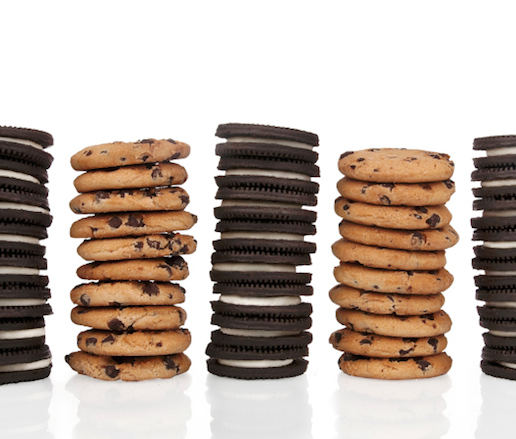Throwback Thursday: Laura Shapiro's "A Food Lover's Guide to Fat"
Kaitlin Hill
Kaitlin HillJune 26, 2014

Remember SnackWell's? In the 1990s America's fear of fat was perhaps even more pronounced than the aversion to gluten we have seen in this decade. In her 1995 JBF Journalism award–winning article, "A Food Lover's Guide to Fat," historian Laura Shapiro addressed the anti-fat frenzy:
Consider the Oreo: two chocolate discs, a creamy filling, and a tradition going back to 1912. For as long as cookie sales have been tracked, Oreos have been the industry front-runner, occasionally jockeying for first place with Chips Ahoy! or Fig Newtons, but always the sentimental favorite. Until this year. When the cookie-and-cracker bestseller list for 1994 is tabulated, last year’s number six will have flown straight up into first place, with Oreos in a dismal fourth. America’s new passion is SnackWell’s. Introduced by Nabisco only two years ago, SnackWell’s is a line of fat-free and low-fat snacks best known for the Devil’s Food Cookie Cake, a morsel of cake and marshmallow wrapped in a shiny chocolate coat. There are many differences between an Oreo and a Devil’s Food Cookie Cake, but none so important as what is printed on the back of the SnackWell’s box under Nutrition Facts: "Total Fat 0g.”
Zero grams of fat! Never mind that an Oreo has a skimpy 2.3 grams of fat per cookie and approximately the same number of calories as a Devil’s Food. Zero means none, and that means a lot. America is in the grip of a fat fanaticism, obsessed with the furtive grams of fat that lurk in our food plotting a hostile takeover of our health and our waistlines. Fat is the leading nutritional preoccupation of grocery shoppers—60 percent of them according to the Food Marketing Institute, a trade association; cholesterol worries on 21 percent and calories a measly seven percent. Fat propelled In the Kitchen with Rosie into bookselling hall of fame: published only six months ago [June 1994], the low-fat cookbook by Rosie Daley, Oprah’s personal chef, has more than five million copies in print and is widely acknowledged to be the fastest-selling book in history. Fat brought the ten largest movie-theater chains to their knees last May, when the advocacy group Center for Science in the Public Interest released a study showing that a medium tub of movie popcorn, popped in coconut oil but without the fake butter, has 31 grams of saturated fat—the kind that clogs your arteries. That’s as much as three Big Macs. Movie-goers gagged, and sales sagged. “Nine out of ten of the chains have abandoned coconut oil,” says Art Silverman of CSPI; they’ve switched to less-saturated vegetables oils. "The tenth has added air-popped popcorn.” Fat is why students at American University in Washington, D.C. are monitoring the nutrients in their food by using a touch-screen computer in the cafeteria; why restaurants from Taco Bell to ‘21’ have introduced nutritionally correct menu items; why Patty LaNoue Stearns, food writer at the Detroit Free Press, found her phone ringing off the hook recently. “There was a fat-free pizza I had written about,” says Stearns. “I must have gotten a hundred calls about that pizza.” Sometimes Maggie Soch, shopping at Tom Thumb supermarket in Dallas is overwhelmed by it all. “There’s ‘light,’ ‘fat free’ and ‘low fat,’ she says wearily. “I spent an hour one day just looking at brownie labels.”
Dietary fat is a problem, all right: it’s been linked to heart disease, cancer and obesity. But whatever we’re doing in the way of anti-fat frenzy isn’t working. Americans are tubbier than ever – one in three of us is obese now, up from one in four as recently as 1980. Rates of breast, colon and prostate, the cancers most often associated with a high-fat diet, continue to climb. And heart disease remains the No. 1 killer of both men and women. All this despite a flock of good-news headlines recently proclaimed, as did the New York Times, AMERICANS REDUCING FAT IN DIET. What’s going on?
Two things. First, most Americans are probably not REDUCING FAT IN DIET, at least not by much, simply because most Americans have no idea what’s in the food they’re eating. In fact, many are being misled by the labels and numbers and definitions that were meant to help them bushwhack their way to more healthful choices. Healthful choices? That’s the second problem: few people can figure out what those are anymore. New studies are raising ever more complicated questions about fat and disease, even about the link between dietary fat and obesity. While nobody in the scientific community has a good word to say for the typical, high-fat American diet, there’s little agreement on how, why or whether it’s leading us to perdition. No wonder the surveys show that Americans are more confused than ever. “We found a lot of people buy low-fat foods but balance them with high-fat,” says Tom Dybdhal of Prevention Magazine, which polls shoppers in conjunction with the FMI. “They’ll buy premium ice cream and nonfat salad dressing.”
Reader, take heart. You can control the fat you eat without resorting to mucilaginous fake salad dressing. Besides. The butterfat in ice cream is a million times worse for you than the olive oil you’re giving up. So have a little oil and vinegar on your salad, have a little ice cream; and then stop eating. (Frankly, that’s the important part.)
[Excerpted from the Winter 1996 issue of Beard House magazine]






